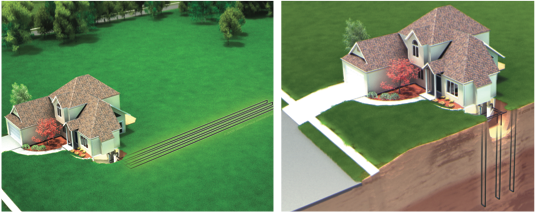22
2011
Difference Between Vertical and Horizontal Geothermal Installations
 There are a few different ways you could have your energy-efficient geothermal heat pump installed to provide year round heating and cooling to your home. The most used method is a closed loop installation utilizing either a vertical or horizontal technique in relation to how the heat circulating pipes are laid out. Which method is best for your home depends very much upon a number of variable conditions.
There are a few different ways you could have your energy-efficient geothermal heat pump installed to provide year round heating and cooling to your home. The most used method is a closed loop installation utilizing either a vertical or horizontal technique in relation to how the heat circulating pipes are laid out. Which method is best for your home depends very much upon a number of variable conditions.
Closed loop is the most common method and within that, horizontal installation is the most frequent closed loop type. A horizontal installation uses a series of trenches excavated around the house where the pipes are deployed. These trenches are not very deep and not particularly expensive to dig. It’s generally a relatively cheap method of installation, but that are some restrictions. Horizontal installation is simply not practical in areas with a lot of rock that will make digging trenches too costly and there must be available space around the house for the relatively high surface area trenches to be laid out. If these requirements are not met, a horizontal geothermal heat pump may be able to be installed.
The vertical closed loop method uses a series of vertical trenches to provide space for the pipes. This method is more expensive as the vertical shafts have to be dug deeper than horizontal trenches. However, some areas of the country are better served by vertical trenches. If space is at a premium or the ground is very rocky, then vertical trenches may be the best or only option.
Whichever method is best for where you live, a horizontal or vertical closed loop geothermal heat pump is going to provide superior energy savings compared to your old air conditioner and furnace. The only difference is going to be how expensive your initial installation costs are and then how quickly the energy savings you accumulate pay back those costs in the years to come.





